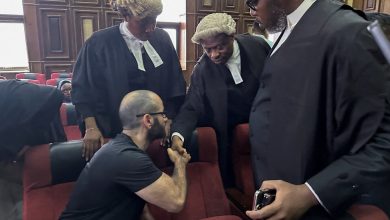Elizabeth Holmes caps her testimony with a round of denials.

SAN JOSE, Calif. — For the six days that Elizabeth Holmes, the founder of the failed blood-testing start-up Theranos, took the stand in her fraud trial, she blamed others, accused a former boyfriend of abusing and controlling her, and reframed her actions as trying to do good for her company.
On Tuesday, Ms. Holmes capped her defense with flat denials.
“I don’t think I did that,” she said in response to a question about whether she had minimized the findings of a devastating regulatory inspection at Theranos. She then blamed her company’s lawyers for “doing a lot of the talking in that meeting.”
The comments ended Ms. Holmes’s main testimony, which stood out as the rarest of rarities. Few technology executives, let alone a female tech executive, are ever charged with criminal fraud. Even fewer take the stand to defend themselves. Her time on the stand, which is likely to formally finish on Wednesday, was the climax to a trial that has captivated the business world and been held up as a parable of Silicon Valley’s fake-it-till-you-make-it culture on overdrive.
Ms. Holmes, 37, has pleaded not guilty to 11 counts of fraud for claims she made as chief executive of Theranos, which she founded in 2003. If convicted, she faces up to 20 years in jail.
Her trial is now moving into its end stage. Either side may call final witnesses over the coming days, followed by closing arguments and detailed instructions to jurors for their deliberations on a verdict.
For most of the proceedings, the jury heard witnesses testify about the details of Ms. Holmes’s alleged fraud. Theranos rose to prominence, raising $945 million in funding, by claiming that its revolutionary machines could perform hundreds of tests using only a tiny drop of blood. The hype made Ms. Holmes a fixture on magazine covers that hailed her as the next Steve Jobs.
But a 2015 expose in The Wall Street Journal exposed problems with Theranos’s blood tests, kicking off a downward spiral of regulatory crackdowns and lawsuits. The company dissolved in 2018, and Ms. Holmes was indicted.
Since her trial began in September, prosecutors have called dozens of witnesses, including former board members, lab directors, employees, investors, patients and business partners. They have revealed the details of falsified documents, outlandish financial projections, unrealistic promises and faked demonstrations at Theranos. Witnesses often spent hours on the tedious minutiae of finance, chemistry, technology and phlebotomy.
Much of the case against Ms. Holmes has relied on her emails and text messages to tie her directly to the company’s problems. Prosecutors must convince the jury that Ms. Holmes knew about the problems and failed to disclose them to the people pouring money into Theranos and to the patients relying on its blood tests to make medical decisions.
In her defense, Mr. Holmes’s lawyers tried showing that the witnesses’ stories were more complicated than they had let on. Defense lawyers hit investors for not doing enough research on Theranos before investing. And they tried blaming lab directors for problems with the accuracy of Theranos’s tests.
Through it all, Ms. Holmes sat up stick-straight in her chair and stared straight ahead, her expression obscured by a mask.
After prosecutors rested their case last month, and before calling Ms. Holmes to the stand, her lawyers introduced brief testimony from a biotechnology executive who joined Theranos’s board of directors after it came under fire from the media and regulators.
Ms. Holmes then offered a variety of excuses for Theranos’s shortcomings. She said others had misinterpreted her statements about what Theranos’s technology could do. She said that, until a 2015 regulatory inspection revealed a host of problems and forced Theranos to void its tests, she believed its tests worked. She said she hadn’t been qualified to run a lab and had relied on the statements of others.
She also admitted to adding the logos of pharmaceutical companies to a series of reports, which implied the drug makers had endorsed Theranos’s technology when they hadn’t. For this, she expressed regret.
Her direct testimony ended with a bombshell revelation that Ramesh Balwani, her former boyfriend, business partner and alleged co-conspirator, emotionally and physically abused her. Through tears, she testified that Mr. Balwani had controlled every aspect of her life — including her schedule, diet and presentation — and had even forced her to have sex with him against her will.
On cross-examination, she choked up again when prosecutors had her read text messages with Mr. Balwani that showed a more affectionate side of their relationship. Prosecutors elicited several more mea culpas from Ms. Holmes, including regret over how she handled thee Journal exposé and a positive Fortune cover story about the company that was later heavily corrected.
This week, prosecutors homed in on the discrepancies between what Ms. Holmes said in her testimony and what investors said she had told them. Numerous Theranos partners and investors testified that they had believed the company had contracts with the military and deployed its technology in medevacs and on battlefields, for example.
One of the prosecutors, Robert Leach, an assistant U.S. attorney, asked Ms. Holmes different versions of the same question repeatedly to hammer the lack of military contracts. She confirmed that Theranos had not had the contracts.
To show that Theranos was never paid for work with the drug maker GlaxoSmithKline, Mr. Leach also repeatedly asked Ms. Holmes about the lack of revenue, posing the question for each year from 2007 to 2014. Ms. Holmes said no each time.
Ms. Holmes resisted many of Mr. Leach’s lines of questioning by testifying that she didn’t recall or didn’t know. She also tried to dispute details in certain questions.
Ms. Holmes’s lawyers questioned her for a second time Tuesday afternoon with a rapid-fire series of statements meant to undermine Mr. Leach’s points and reiterate her initial testimony. Once again, Ms. Holmes said that Mr. Balwani had created Theranos’s unrealistic financial projections and that Theranos’s scientists had put together reports on its technology.
Until a regulatory inspection revealed deeper problems, she testified, she thought Theranos’s lab was “excellent.” Ms. Holmes also repeatedly stressed her concerns over exposing Theranos’s trade secrets as an excuse for withholding information from investors and partners, testifying again that she worried the company would lose its ability to compete. Discussing Theranos’s use of third-party machines would have violated Theranos’s own trade-secret policy, she said.
Mr. Leach tried knocking down that argument by noting that most of Theranos’s investors and partners had signed nondisclosure agreements that Ms. Holmes expected to be followed.
He further noted that, despite Ms. Holmes’s holding a patent for some technology, a patent did not “necessarily mean the invention described in the patent works.” Mr. Leach asked her if she had created a pill that measures lipids in blood, as described in one Theranos patent.
Ms. Holmesleaned into the microphone and said, “Not yet.”




